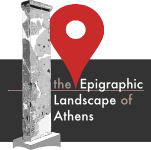SEG 26, 120Supplementum Epigraphicum Graecum (Geagan); SEG 30, 80Supplementum Epigraphicum Graecum (ll. 6-24 revised, Oliver)
Inv. number
Ag. I 2351 + Ag. I 1619
PHI
Translations
AIO, AXON, IG Online
Description
Date
Period: 1st century BCE --> first half --> before 86 BCE, Sulla's sack of Athens,
1st century BCE --> first half --> after 86 BCE, Sulla's sack of Athens
✓disputed
Reasons: historical context, prosopography
See notesThe date of the present decree is much controversial and scholars still debate on its chronology. Since the decree appears to deal with democracy (l. a 7), it has been associated to the context of the First Mithridatic War and has been assigned, in turn, to 84/3 and the oligarchic constitution established after Sulla's victory at Chaeronea (Geagan), to the regime of Athenion in 88/7 (Badian) and to the year of Sulla's siege of Athens, 87/6 (Oliver). Oliver himself, however, has also proposed to date it to the return of democracy in 70/69 BCE. The poor state of conservation of the text has instead convinced Habicht to support the idea that the decree should not be dated at all, as it may refer to the pre-Sullan era as well as post-Chaeronea Athens.
See SEG 26, 120Supplementum Epigraphicum Graecum; SEG 30, 80Supplementum Epigraphicum Graecum; SEG 49, 128Supplementum Epigraphicum Graecum
Text category
decree, law
See notesThe interpretation of this text is as disputed as its chronology.
Firstly it is not clear if it reports a resolution of the Boule and the Demos ratified after a preliminary action of the Demos (l. a 5: [... ἔδοξεν τῶι δήμωι]; a 16: ἀ[γαθῆι τύχηι δεδόχθαι τῶι δήμωι]). In any case, it should bear the official acceptance of a law code firstly approved by the Areopagus (ll. a 17-18). Ll. a 3-4 show us that the Assembly gathered after having been transferred from another place ([... ἐκκλησία ἐν — — —] ἡ μεταχθεῖσα [ἐκ — — —]), as it happened frequently in the II cent. BCE, especially from Piraeus to the Theatre of Dionysos. The proposer of the decree is Demeas son of Demeas, from the deme of Azenia or more probably of Halae (l. a 6).
From l. a 6 it begins the ἐπειδή-section and especially from that point the restorations of the main editors, Geagan and Oliver, appear to be even more tentative. Particularly controversial is the interpretation of ἐν δημοκρατίαι at l. a 7, which may refer either to the democratic government established at that time in Athens (Oliver), or, as a contrast, to a oligarchic constitution (Geagan), perhaps revealed by the association of election and sortition as opposite ways of appointing magistrates (l. a 8) and by the key role played by the Areopagus in those years. Other debatable points are the references to allotment (ll. a 8, 10, 20, 23) and to equality (l. a 14: κατὰ τ[ὸ ὅ]μοιον), the mention of Athenion, restored at l. a 17 by Badian and Oliver ([τὰ] μὲν προνενομοθετημέν[α σὺν Ἀθηνίωνι(?)...]), which would point to the regime founded under Mithridatic patronage, and the presence of elected public defenders ("syndikoi" or "synegoroi") at l. a 12.
Oliver saw in the political theory behind the text a "Peripatetic colour" which makes it possibile to assign it to Athenion and to the archonship of Philanthes (87/6 BCE) and restored the text following Aristotelian principles; the validity of such reconstruction has been recently defended by Antela-Bernárdez, ZPE 171, 2009, 105-108Zeitschrift für Papyrologie und Epigraphik, Köln 1967-, who believes that the new constitution was composed by Demeas himself, Apellicon and Athenion in 88/7, the year of "anarchy", and then approved in the following year with the purpose of favouring the newly-appointed citizens enriched through commerce, representing the new elite of the city.
On the disputed interpretation of the text see Habicht 1995 318-320Habicht Ch., «Athen. Die Geschichte der Stadt in hellenistischer Zeit», München 1995.
Monument description
Monument type: stele
Material: white Pentelic marble
Letters Height Mt: 0.009-0.01
Physical features
Measurements: h: ca. 0.385 * w: 0.25 * t: 0.08
State of conservation: Left side preserved
Legibility: Twenty-four lines of text (left portion). The lettering looks neat, at least superficially; the dimension of circular letters is not regular and serifs were cut perfunctorily
Reuse: Reused
See notesFragment formed by two joining pieces.
For a photo see Hesperia 40, 1971, pl. 16 no. 3Hesperia: The Journal of the American School of Classical Studies at Athens, 1932-
Measurements: h: 0.09 * w: 0.053 * t: 0.083
State of conservation: Broken on all sides
Legibility: A very few letters of five lines of text
Reuse: Reused
See notesSmall non-joining fragment.
For a photo see Hesperia 40, 1971, pl. 16 no. 3Hesperia: The Journal of the American School of Classical Studies at Athens, 1932-
Findspot
Date of discovery: 1935
Circumstances: archeological excavation
Geagan, Hesperia 40, 1971, 101-102 no. 3Hesperia: The Journal of the American School of Classical Studies at Athens, 1932-
Found in a late context over the south porch of the New Bouleuterion (F 10)
Date of discovery: 1934
Circumstances: archeological excavation
Geagan, Hesperia 40, 1971, 102 no. 3Hesperia: The Journal of the American School of Classical Studies at Athens, 1932-
Original location
Since both fragments were reused in the Agora, the original location of the decree should be searched in a building of that square, although we cannot rule out also a place on the Acropolis or in the area between the Areopagus and the Agora.
Keeping in mind these remarks, it is perhaps possible to suggest a parallel with another decree of the I cent. BCE dealing with a democratic constitution (IG 2[2] 1062Inscriptiones Graecae II et III: Inscriptiones Atticae Euclidis anno posteriores (2nd ed., Pars I-III, Berlin 1913-1940; Pars V: Berlin 2008), Ed. J. Kirchner = ELA id: 276), which preserves the publication provision for the Acropolis and the law courts of Athens. As well as in that case, we may think that also the present constitutional approval of the I cent. BCE, which might have included judicial regulations as well, was set up in more copies in prominent places of the city, like the Acropolis, the Agora or the area of the Prytaneion. The great square, in fact, especially on its north-east corner, had housed buildings often considered by the archaeologists as the judicial courts of Athens. Nevertheless, in that area the last of those buildings seems to have hosted a law court only until the beginning of the II cent. BCE. Although it is not clear the relation of the present inscription with Athenian judicial activities, it is particularly interesting that beneath the north part of the Stoa of Attalos, in the buildings recognized as law courts, have been found several "psephoi" and a "ballot box" that may recall the practice of allotment mentioned at least four times in the present inscription.
Other Agora buildings probably used as law courts in the II cent. BCE were those of the South Square, like the East Building, the Middle Stoa, the South Stoa (II), perhaps not incidentally occupying the area in which Frg. a has been reused (see Ath.Agora 28 91-98Boegehold A., «The Athenian Agora XXVIII. The Lawcourts at Athens: Sites, Buildings, Equipment, Procedure, and Testimonia», Princeton 1995; Dickenson 2017 153-157Dickenson C.P., «On the Agora: The Evolution of a Public Space in Hellenistic and Roman Greece (c. 323 BC – 267 AD)», (Mnemosyne supplements 398), Leiden - Boston 2017).
Moreover, the discovery in the Plaka of a new decree dealing with lawcourts and a new (still unpulished) "ballot box" has enhanced the possibility that in Late Hellenistic Athens texts regarding judicial regulations and settlements may have been set up in the district of "dikasteria" close to the Prytaneion and the Theseion; cf. ELA id: 347 = Papazarkadas, Hesperia 86, 2017, 325-352Hesperia: The Journal of the American School of Classical Studies at Athens, 1932- and IG 2[2] 1062Inscriptiones Graecae II et III: Inscriptiones Atticae Euclidis anno posteriores (2nd ed., Pars I-III, Berlin 1913-1940; Pars V: Berlin 2008), Ed. J. Kirchner = ELA id: 276.
✓uncertain
IG 2[2] 1062Inscriptiones Graecae II et III: Inscriptiones Atticae Euclidis anno posteriores (2nd ed., Pars I-III, Berlin 1913-1940; Pars V: Berlin 2008), Ed. J. Kirchner = ELA id: 276 (copy of) ?
On the buildings housing law courts in the north-east corner of the Agora and the finding of materials related to sortition see Camp 2010 119-122Camp II J.McK., «The Athenian Agora: Site Guide», Athens 2010.; Topografia di Atene, 3** 1147-1151E. Greco (a cura di), «Topografia di Atene. Sviluppo urbano e monumenti dalle origini al III sec. a.C.», Tomo 3**: «Agora del Ceramico», Atene-Paestum 2014.
On the Prytaneion cf. Topografia di Atene, 2 535-537, F42 (Di Cesare)E. Greco (a cura di), «Topografia di Atene. Sviluppo urbano e monumenti dalle origini al III sec. a.C.», Tomo 2: «Colline sud-occidentali - Valle dell'Ilisso», Atene-Paestum 2011; on the Theseion cf. Topografia di Atene, 2 551-553, F47 (Di Cesare)E. Greco (a cura di), «Topografia di Atene. Sviluppo urbano e monumenti dalle origini al III sec. a.C.», Tomo 2: «Colline sud-occidentali - Valle dell'Ilisso», Atene-Paestum 2011


